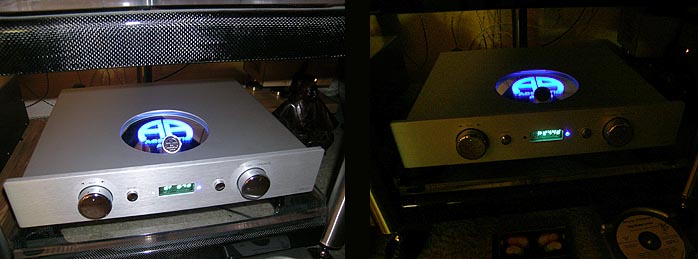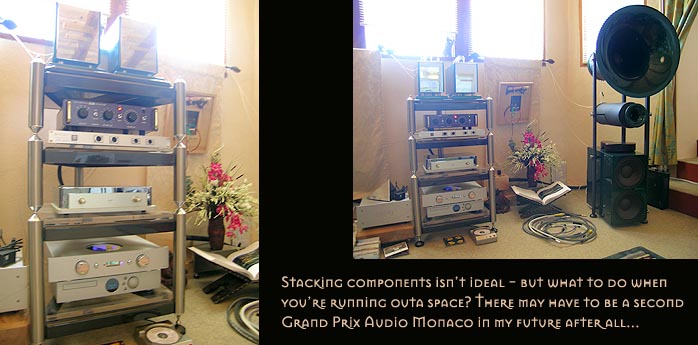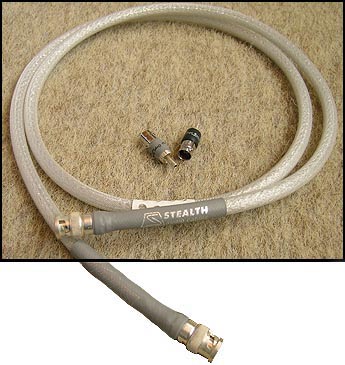 |
|
|
Very much like Ensemble in neighboring Switzerland; Linn, Meridian and Naim across the Chunnel; and Burmester on its own native soil, Accustic Arts by Schunk Audio Engineering GmBH of Lauffen (situated in Germany's picturesque Neckar valley) is a complete systems provider. That's something US firms traditionally struggle with if it is even attempted. The present Accustic Arts offering includes the digital separates and CDP already mentioned; a preamp, integrated amp, stereo and mono amps; speakers; cables and cords, with the speaker cables incorporating HMS-reminiscent ferrite beads; active and passive power strips; and even an equipment rack. A surround-sound processor is forthcoming, too.
|
|
 |
|
 |
|
|
| Placing the 33 lbs of the Drive 1 into my Grand Prix Audio Monaco rack displayed just how nicely its clean silver/chrome look complemented my Zanden DAC. As you would expect, operating it didn't require even a single reach for the owner's manual. After all, a CD transport is a CD player without analog outputs. It merely reads the binary encryption of the polycarbonate music discs and passes this digital datastream to an outboard digital-to-analog converter. The qualifier merely is up for discussion though. If capturing the encoded data was a function of merely, transports as a breed separate from one-box CDPs wouldn't exist. Nor would sonic differences between transports which seem to be |
|
a function of ultra-low jitter (fidelity in the time domain so that the left/right-channel bits are reassembled in perfect sync); rock-steady speed stability; and minimal interference from guesstimating error correction circuitry to extract actual, not interpolated data.
Most upscale digital transports incorporate internal resonance control solutions just as is standard with turntables. You want to optimize the fast-moving interface between variable-speed spinning disc and stationary laser pickup. Bearing and drive-motor quality are further variables. Still, for non-engineers, the sometimes profound sonic differences ascribed to transports seem to make little rhyme or reason when faced with variations on the diehard argument that "it's just reading 1s and 0s, any bloody computer drive can do that perfectly".
On the face of it, this argument seems perfectly sensible. Would listening bear it out? After all, HighEnd audio is anything but sensible.
|
|
 |
|
|
|
|
Let's start with El Lebrijano's Suenos en el Aire [Ediciones Senador 02803], specifically the last track "Gelem Gelem". It sports piercing Romanian female Gipsy vocals with accordion, then transitions seamlessly to powerful male Flamenco vocals with guitar.
|
|
 |
|
| I'm not sure exactly what I expected a transport swap to accomplish - but the results were clear as a bell and completely unambiguous: The stand-alone transport removed a slight fuzziness as though performer outline edges with the Cairn were a bit frayed like the hems of worn-out jeans. Put |
|
|
|
 |
|
differently, the Cairn sounded softer and a bit more indistinct like a warmish tube amp. The Accustic Arts was more incisive and piquant particularly on the leading edge - like most solid-state or a few superior tubes.
This particular recording with its two very direct and cutting voices was nearly a poster child for this difference which played out very much like the well-known nearfield/farfield shift between transient acuity and heightened ambient blending. Move closer to the stage and you diminish the slightly blurry qualities of blending the original signal with hall reflections and echo. Move farther away and diminish the explosive sharpness of rise times. Where this simile falters is in the underlying suggestion that the Drive 1 would likewise minimize ambient information. It did not.
Rather, the removal of 'cobwebs' and a subliminal opacity equated to heightened clarity not just on the instantaneous sound bursts from silence but also their subsequent rise and fall back into silence. The Cairn didn't seem so much veiled by comparison as simply a bit polite and less assertive. To be honest, I was surprised both by how well it held up and how obvious the differences were. Personally, I want my source to be as highly resolved as possible. On that front, the Accustic Arts was a very non-subtle step in the right direction.
That said, I can also imagine systems that aren't quite ready for such an increase of resolution with its concomitant sharpness of greater relief between silence and sound. My tube-based system is not of the aggressive in-yer-face religion of brutal honesty and thus responded in a very copasetic way to this stripping away of 'intermolecular' gunk. As always, maintaining balance becomes the overriding challenge here. Conceptually speaking, if an increase of source component resolving power equated to nastiness on the tail end, such problems might be more appropriately blamed on something further down the chain. If it's on the recording, you should want to know about it. |
|
Unprepared for how readily the contributions of the Accustic Arts drive had been audible on this recording, and in how focused a domain of activity they'd been concentrated -- at least on such relatively simple material without extended bass -- I deliberately grabbed something far less natural but massively bass-heavy next: AfroTech. The album? West Nile Funk by Ex-Centric Sound System [Indieland/EXS 2-004]. The track? "Alice in Voodooland".
|
|
The differences were now less distinct, with the Accustic Arts' solitary minor advantage one of better grip and thus pitch definition of the ultra-low bass. Infrasonics are relatively rare on acoustic material but can be great fun on Techno/Ambient-style fare if you own true full-range monsters like my Avantgarde Duos or the Gallo Acoustics Reference3s with (non-optional in my mind) bass amp. However, if an overriding portion of your musical diet was electronica, I dare say that the sophistication of what the Drive 1 brings to the table might not make a large-enough dent to be worth the expense. If I was a rave fiend, I'd take those $4,800 and sink them into superior subwoofer firepower.
|
|
|
|
 |
|
 |
|
|
Returning to the purely acoustic milieu with the Portuguese non-Fado singer Filipa Pais and L'amar [Strauss 03011010242], the piano and saxophone of "Deus te salve o rosa" -- recorded in a very wet, reverb-rich acoustic -- once again showcased the German disc spinner's removal of indecisiveness and 'foggy milk soup' whereby the Cairn dealt with the ambient information. Because of the encoded far-field perspective, the previously noted leading-edge sharpness was less in evidence now. What was obvious as daylight? The greater intelligibility of vocal and instrumental lines embedded in the recorded ambience - less bleeding of one into the other, more separation and thus less shadowing of tertiary signal by secondary and primary 'bigger fish'.
|
|
|
I recently talked with Ensemble's Urs Wagner on the phone. How much better did he feel were his new separates than the integrated Dirondo one-box CD player? "About 15%" he answered very honestly and without delay. "You'll hear a better reconstruction of the original recording venue." Such are the effects of diminishing returns. What's worse, while 15% is a tremendous gain in the usual audiophile clawing for mere single-digit improvements, you will only hear all of such possible improvements if your system is of high enough resolution to begin with. Some data bottleneck or weak link anywhere in the chain could seriously cut back those 15% to make the associated expenditure seem less than stomachable.
|
|
|
 |
|
Coming up with percentile improvement figures can always only be a rough indicator to communicate how substantial (or not) one feels a component stepped up overall system performance. Compared to my relatively affordable but very good single-box Cairn -- and on the predominantly acoustic music I listen to -- the Accustic Arts proved to me that my statement-level Zanden DAC does indeed deserve a mate of equal breeding to really make for a ne-plus-ultra digital front-end. How much better could or would the $17,970 Zanden Model 2000 transport without reclocker be? Or the $7,980 Ensemble Dirondo? That indeed is the million-dollar question I'm hoping to answer in the not-too-distant future.
|
|
For today and after my first experience with dedicated transports, I can already tell you that the 1s and 0s are all the same argument clearly doesn't wash. In fact, an upcoming investigation into different BNC-terminated digital cables will prove much the same (incidentally, today's report used the excellent Stealth Audio Cables Varidig). Already at this early stage of my digital separates games, it seems pretty much a given that in order to continue my review work with as revealing a source as possible, I will have to muscle up to the greasy plate and consider acquisition of an outboard disc spinner. (Can I make this a tax write-off?) Which transport I'll be able to afford and which one will offer the sanest combination of cost, performance and good looks to my ears and eyes is still in the moons. But if you are currently running an upscale DAC tethered to some multi-purpose CDP or DVD player, you should borrow a dedicated transport just to find out how much more your DAC might be capable of extracting from your discs. Like me, you could be surprised and decide that one of the more no-brainer investments into this audiophile madness really is at the source. As any cook will tell you, no matter how fancy your appliances, knives and pans, it's all for naught if you start with inferior ingredients.
|
|
 |
|
In summation
There was nothing about the Accustic Arts Drive 1 I didn't like or secretly wished to be different. It's build like a tank, looks like a fine piece of jewelry, doesn't lack any features I'd consider essential and definitely performs in the areas of heightened presence lock with vocals, more percussive incisiveness with transients and better visibility into the micro-data domain of recorded acoustics. Considering the going rates for competing options, its selling price resides on the lower end of the scale and, though not insignificant, actually makes it into one of the more affordable contenders in this admittedly specialized and rarefied sector. While I'm still too inexperienced with stand-alone transports to succinctly know where to place it within the greater context of what's available, I'm rather convinced that this machine's very strong first impression will prove imperturbable regardless of what future encounters may hold 'round the digital bend. And I did say that its cosmetics really are something to behold, didn't I? Color me lustful then.
|
|
|
|
|
|
 |
|
|
|
 |
|
 |
|
|
|
|
|
 |
|
|
|
|
|
|
|
|
|
|
|
|
|
|
|
|
|